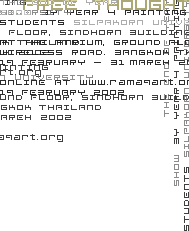| Space in Art The one problem that artists in each period have to deal with is the creation of space, that is, the question that challenges artist's intellectual skill. An artist can create the illusion of the audience's eyes by creating various kinds of artistic elements according to perspective strategy. The creation of space affects every aesthetic aspect:
It makes the mass form become outstanding.
The space itself can be a sort of symbolic art, and designed to be as variable as an artist demands it to be. Space can be arranged in various patterns, for instance
- space occupied by mass form
- the interval between each form and space division
- enclosure space
- two-dimensional plane as picture format
- 3D illusive image on 2D surface of the painting
- device for making optical art which empty space and art elements deceive eye perception in reverse Space can be divided in to three types
1. Positive space: the inner space of any visible form.
2. Negative space: the surrounding space that emphasizes forms in 2D pictures.
3. Neutral space: the empty space where there is no form, background or foreground in 2D pictures, here is, the picture format. On one hand, space is one of the blank pieces of type. On the other hand, it means the relation between occupied space and empty space of the three-dimensional field. What has to be considered are how suitable a space can be and what role a space is playing, the main subject matter or just the complement. For painting, the exhibiting space is pondered as a part of the work. Not only the space within the picture, but it is the place to settle one down that will effect balance in the painting. Talking about balance, which is another portion of composition, has a complete connection to the painting, especially the symmetrical composition as well as space that the audience may examine. The creation of space could be an effective device in the art process. The discrimination of space and space division will benefit the beauty within artistic works and other compositional elements as long as man has got the eyes to behold nature, the brain and intellect for scrutinizing sense. The relation between space and the work of art is an important part that an artist should consider. This could either elevate or devalue the aesthetic in an art piece so that the audience would be misled from its true intention. Pranom Khuaklang
Artist | 
